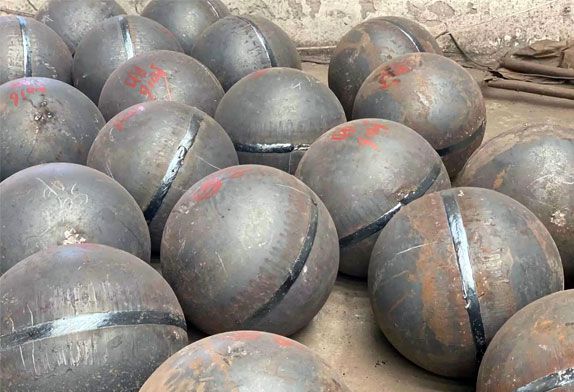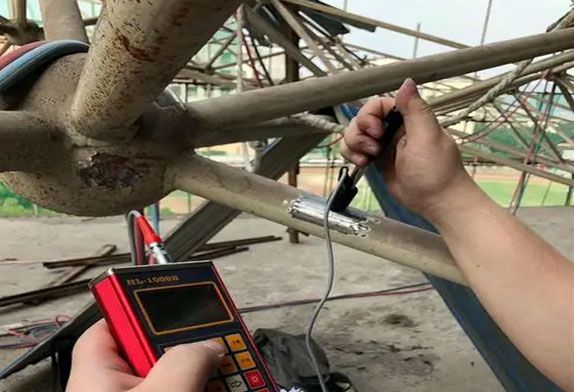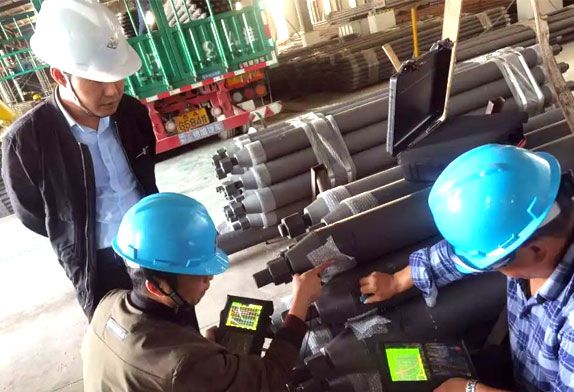The application of steel structures has greatly improved the quality of buildings. In the construction, the steel structure should be welded together, and the welds should be detected to ensure that the quality requirements are met. The traditional detection method is backward, the weld may be damaged in the process, and the quality of the steel structure may be adversely affected. Effective application of non-destructive testing methods to achieve effective detection of steel structure welds, to provide quality assurance, for building quality is of great significance.
1. Weld type of steel structure


Steel structure welds play an important role in building structures. Common joint forms include butt joints, tower joints, and so on. With the development of the construction industry, people pay more and more attention to the application of steel structures, which is of great help to improve the quality of the project. The steel structure has the advantages of high strength and lightweight. Compared with other materials, it has obvious advantages and higher comprehensive benefits. Steel structure material plasticity is good, there will be an obvious yield area under the action of tensile force, and there will be no sudden fracture due to excessive weight. The steel structure installation speed is fast and the construction efficiency is high, because the steel structure parts have been produced in the factory in advance, and only need to be assembled on site, which is very simple. The steel structure can be connected by welding, which can be used in engineering construction and effectively improve the overall quality. Weld quality detection is a problem that people attach great importance to. In the welding process, adverse factors will lead to the reduction of quality, the most common is the crack problem. In order to ensure the quality of steel structure weld, it is necessary to actively carry out the detection, the main purpose is to find defects in time and improve the quality through improvement. Realize the importance of steel structure weld detection, combined with the actual situation to carry out the detection work, to provide a reliable guarantee for the quality of steel structure.
2. Development history of nondestructive testing technology
The application of non-destructive testing technology has experienced a long period of development, which mainly includes three stages, namely non-destructive detecting, non-destructive testing, and non-damage. NDT is to detect and find defects. NDT should understand the shape, location, and other information of defects besides detecting and finding defects. The meaning of non-destructive evaluation is very broad. It is not only necessary to find defects and understand the basic situation, but also to obtain more comprehensive information to evaluate the operation status and service life of the detected object. Non-destructive testing methods used in the steel industry include magnetic particle testing, penetration testing, etc., which can find defects in time and effectively avoid the impact on project quality. At present, nondestructive testing technology is in rapid development, which can adapt to the actual development needs, so it is necessary to improve the level of cognition. The development trend of non-destructive testing technology is prospected, which will develop in the direction of intelligence and automation, be more convenient for people to use, and improve the level of steel structure defect detection. Strengthen the awareness of innovation, improve the level of technology application according to the development needs, and provide strong support for the development of the industry.
3. Advantages of nondestructive testing of steel structure welds
In the process of steel structure welding, welding structure form, and material selection, any problem will affect the quality of welding, so it is necessary to carry out comprehensive control, and avoid adverse factors, to ensure the quality of the weld. From the current situation, there are many methods of steel structure components testing, among which non-destructive testing is a new high comprehensive performance testing technology. It uses chemical and physical methods to obtain internal information about components and uses professional instruments and equipment to detect the welds of steel structures, and the whole process will not damage the steel structure components, which can ensure structural integrity and safety. The biggest advantage of the non-destructive testing method lies in its advanced nature, which ensures the good performance of steel structure members and will not affect the construction quality. Because of the advantages of non-destructive testing methods, the scope of application is constantly expanding, providing a reliable guarantee for the quality of steel structural members. Strengthen the research of non-destructive testing technology, and the development of the industry, to ensure that it can play an effective role in the actual work.
4. Application characteristics and status quo of nondestructive testing methods
4.1 Application Characteristics
The biggest advantage of the non-destructive testing method is that it is non-destructive, and the steel structure members will not be damaged in the process, which effectively ensures quality. In the actual detection, when the shock wave measures the thickness of the weld, there is a large difference between the final result and the evaluation standard, which is affected by human factors and will reduce the quality of the construction project. For this kind of common problem, the use of non-destructive testing technology can ensure the accuracy of the results, but non-destructive testing technology also has shortcomings, in the steel structure weld detection, in addition to the detection of internal structure damage, but also tests the durability of the material, the current non-destructive testing technology can not meet, limiting the role of play. Nondestructive testing technology has broad application prospects, so it is necessary to enhance the innovation consciousness and break through the technical limitations, so as to better apply to the actual testing work. The practice has proved that nondestructive testing technology is an advanced technology, which can meet the actual needs. At the same time, it is necessary to summarize the problems in the work, accumulate rich experience, and constantly improve the application level of non-destructive testing technology to provide a guarantee for the quality of steel structural members. Comprehensive analysis of technology application, clear development direction, give play to the advantages of new technology, to ensure the quality of steel structure components.
4.2 Application status
Welding is an effective way to connect steel structures. Welds can be classified according to the connection position between the base metal and the weld, including fillet welds and butt welds, where fillet welds can be divided into oblique fillet welds and right fillet welds, and butt welds can be divided into partial penetration welds and complete penetration welds. When classifying the weld quality, it is necessary to comprehensively consider the stress condition, working environment, and other factors. At the same time, according to the “Code for Steel Structure Design”, different quality grades of welds have corresponding steel structure construction quality acceptance standards, and internal quality inspection and appearance inspection of steel structure welds. Among them, the internal quality inspection is based on the relevant requirements, the effective use of ultrasonic testing technology, to detect whether the internal weld is intact, if internal defects are found, and the use of ray testing technology. Nondestructive testing technology has achieved some results in practical applications, but there are still problems, so it is necessary to improve, in order to play a greater role. In particular, the problems in the application must be summarized and analyzed to achieve a breakthrough in non-destructive testing technology and provide technical support for steel structure weld testing. The detection method is optimized to make it more efficient and convenient, improve the accuracy of the detection results, and understand the specific situation of steel structural members.
5. The concrete application of the nondestructive testing method for weld of steel structure


5.1 Radiographic flaw detection
The principle of this detection method is to use Y-rays and X-rays to penetrate the object, and by analyzing the attenuation intensity of different parts of the object when the ray penetrates, it can detect whether there is a defect inside. When using ray inspection, according to the shape and size of the defects on the film, it can determine whether there is a quality problem, classify the quality of the weld, and provide quality standards for product acceptance. Ray flaw detection is suitable for steel structures with high requirements for airtight performance, such as ships, boilers, etc., usually using ray flaw detection, the actual effect is very good.
5.2 Ultrasonic flaw detection
The so-called ultrasonic flaw detection refers to the non-destructive testing method of using ultrasonic to detect the internal defects of materials. The ultrasonic frequency is relatively high, the principle of ultrasonic flaw detection is to use the ultrasonic probe to send high-frequency ultrasonic waves into the object, the ultrasonic wave in the same uniform medium will be straight line propagation, when the propagation medium changes, their will be reflection or refraction phenomenon, the use of the probe to collect information, through the ultrasonic instrument amplification, intuitive display on the display screen, The staff judges the defect type according to the waveform and wave height. Ultrasonic flaw detection has the advantages of simple operation, low cost, and no damage to the human body, so it has been widely used. The disadvantage is that in the actual detection work, the staff is required to have a professional level. If the technical equipment is not skilled, the accuracy of the detection results will be affected. It is necessary to analyze the shortcomings and improve the detection level through improvement, which is helpful to strengthen the application effect and adapt to the needs of development.
5.3 Penetration detection
Before using the penetration detection technology, the detected object should be processed first, mainly with liquid containing fluorescence for penetration. Under the action of capillary phenomenon, liquid can penetrate into the defects of surface openings. The excess liquid on the surface of the object should be removed, processed and dried at the same time, and then applied to the surface of the imaging agent. Under the effect of capillarity, the imaging agent will adsorb the permeate in the defect, and after light, the permeate in the defect will be shown, so that the specific situation of the defect can be clearly known. Penetration detection technology is suitable for non-multi-port steel structure surface defects, with the advantages of operation detection and intuitive detection. The disadvantage is that the application range is narrow, and the smoothness of the detected object is high. If the surface of the object has paint, rust, and other substances, it is easy to miss detection. The advantages and disadvantages of penetration detection technology are clarified, and scientific and rational use is carried out to ensure that it plays an effective role.
5.4 Magnetic particle testing
The working principle of the magnetic particle flaw detection method is to use the magnetic property of steel to magnetically magnetize the steel structure, which will produce strong magnetic induction inside, and the magnetic field line density will change greatly. If there is a defect in the structure, the magnetic field line will change. In addition, according to the characteristics of the leakage magnetic field of the defective part, it can accurately judge whether there are defects and the current situation of the steel structure. Non-destructive testing of magnetic particle flaw detection has the characteristics of low cost and flexibility. The disadvantage is that the internal steel structure can not be detected, and it will be affected by the size and shape of the material, so there will be limitations in practical application.
5.5 Infrared thermal imaging detection
With the development of detection technology, infrared thermal imaging detection has appeared, which is one of the more popular technologies in recent years. The infrared thermal imaging instrument is mainly used to detect the steel structure, and the required data information is extracted according to the temperature field displayed. This technology has the advantages of high precision and visual image and is suitable for long-distance and large-scale detection. Infrared thermal imaging detection is a breakthrough in nondestructive testing technology, which has attracted the attention of the industry. However, due to the short development time of the technology, it is still in the exploratory stage and not very mature. From the perspective of future development, the application value is relatively high.
The steel structure is an important part of the construction project, if there is a problem will affect the overall quality, so to strengthen the detection. There are many types of steel structure welds, so it is necessary to use reasonable detection methods to find defects in time and improve them to ensure the quality of steel structural members. Strengthen the research of new technology, improve the level of non-destructive testing, guarantee the quality of steel structure, improve the strength of building engineering, and promote the sustainable development of the construction industry in our country.











 About Us
About Us 2023-03-13
2023-03-13


